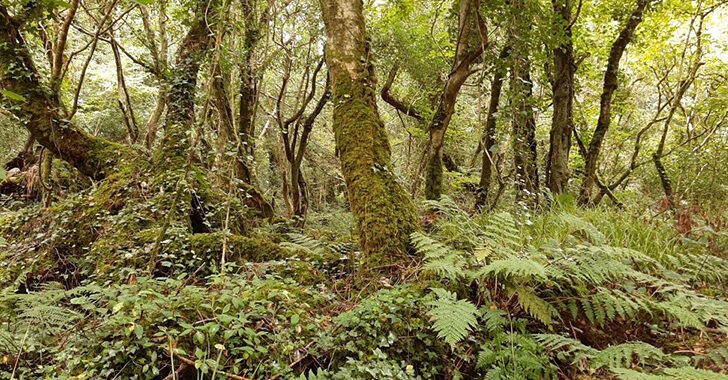An Irish Atlantic Rainforest: A personal journey into the magic of rewilding,
by Eoghan Daltun (Hachette Books, €19.99/£16.99)
Christopher Moriarty
ainforest is a word all too familiar to conservationists. The context is usually the forlorn one of the replacement of tropical rainforest by intensive cattle grazing for the ultimate production of beefburgers. With this background, the concept of a book on an Irish rainforest brings one up rather sharply, even MR Daltun, though the inclusion of the word ‘Irish’ introduces an element of local – if surprising – interest.
This book whose full title is An Irish Atlantic rainforest: A personal journey into the magic of rewilding is substantially autobiographical and introduces a very remarkable man of many talents, not least amongst them an impressive ability to write and describe people, places and, perhaps above all, the evolution of the Irish landscape in the course of the past five thousand years or so.
Beauty
The beauty and importance of this same landscape provides the main thrust for the book, bringing the reader to the realisation of the value to humanity itself of the wilderness.
The book begins with comments on a location far from any rainforest but with a surprising account of the regular early morning communication of monkeys – a parallel with their habit throughout the world. The difference is that this particular community lives in cages in the zoo in Dublin’s Phoenix Park. The zoo is within hearing range of Kilmainham, an ancient region of the city of Dublin where the author discovered the last traces of an 18th Century stone-built cottage, purchased the property and set to work by hand to restore it to its equivalent state as a modern dwelling and adopt it as his home.
This chapter establishes the credential of Eoghan Daltun as no ordinary man. We learn that he is a highly qualified sculptor, employed by various public authorities throughout the land as a restorer of monuments large and small. A subsequent chapter describes with a wealth of detail how he leaves Ireland to live for seven years in Italy. But it is far from being the Italy familiar to most of us. He lived and studied amongst the marble quarries of Carrara, a place of inspiration for European sculpture since Classical times.
West Cork
But, however interesting, this is all diversion, a prelude that leads to his central theme, which begins on a summer’s day in 2008. The family embarks on a trip to West Cork, to the hills, woodland, seaside and rocky landscape of Beara.
There the author fixes his eye on a property, which includes sheep pasture and a pocket of ancient and seriously deteriorated woodland – technically speaking a specimen of Irish Atlantic Forest. He sets to work on managing this plot to restore its ‘wildness’. Involving fencing out cattle and goats, this meets with a very remarkable and rapid transformation with the growth of sapling trees and the appearance of an abundance of wild flowers.
His description of the new landscape that he has produced is a sheer pleasure to read – but one which leads to very serious conclusions. Our Irish countryside is, ecologically, a sadly depleted entity. Thousands of years of human influence, mostly in the shape of chance discoveries, rather than knowledge-based management, have led to this state.
Eoghan Daltun has shown by his own achievement the way in which corrective measures can be successfully applied and makes this a basis for the consideration of his great aim of the ‘regreening’ of Ireland, to say nothing of a very much greater area of land worldwide.
The Lost Rain forests of Britain,
by Guy Shrubshole (William Collins, £20.00/€24.99)
Peter Costello
This book, which has received a lot of notice on television, gives a contrasting overview with the rain forests in our neighbouring island, and the efforts to explore, protect, and to preserve other threatened tracts of similar ancient growth. Readers will find that it places Eoghan Daltun’s activities in a larger context. To see our situation in Ireland in a broader view is very helpful, suggesting such efforts will become more commonplace, and so even more acceptable.


 A patch of Irish Rain Forest (Irish Wildlife Trust)
A patch of Irish Rain Forest (Irish Wildlife Trust) 